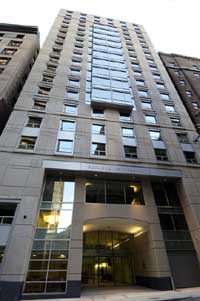BOSTON — Students studying at Boston colleges are finding it increasingly difficult to find decent and affordable living situations. One of the main issues for the men and women at Suffolk University is that their school is located in the affluent Beacon Hill area, which provides very few inexpensive options. Scholars may be asking themselves, well where do I live now? Suffolk has two dorms: 150 Tremont St. and Nathan R. Miller Hall. The newly added 10 West ‘student apartments’ were built to accommodate more students, however the three dorms can only accommodate a small portion of the school.
Scholars may be asking themselves, well where do I live now? Suffolk has two dorms: 150 Tremont St. and Nathan R. Miller Hall. The newly added 10 West ‘student apartments’ were built to accommodate more students, however the three dorms can only accommodate a small portion of the school.
This leaves the rest of the campus population relying on finding an apartment or commuting from a neighboring city.
Although convenient, even the dorms are marked at high prices. A double/triple room costs $5,560 a semester and a single room costs $6,310 a semester. Suffolk’s dorms are rated as the second most expensive dorms in the country.
Lauren Pesinis, sophomore at Suffolk, is enjoying her second year in the Nathan R. Miller Hall. When asked about her living situation, she said, “I love the dorms because they are clean and close to everything on campus. The negative is that the cafeteria food is horrendous.”
Pesinis, along with numerous other students, chose the dorms because of their proximity to classes and despite the steep cost, they do not compare to the escalating cost of apartments.
John Aprile, 20, lives on Temple Street in the heart of Beacon Hill. Aprile explained, “The commute is great. I have to walk next door to go to my classes.”
There are, however, downsides to living in downtown.“The rent is ridiculous. Between me and my roommate, we spend $2,200 a month and that doesn’t include utilities.”
The financial status of the real estate market is partially to blame because as prices continue to rise, tenants become less likely to rent or buy. The average cost of living in a Boston apartment is $1,900 a month, ranking 48% more expensive than the national average.
Unless studying in Boston with a bottomless bank account, renting an apartment in downtown is not ideal.
Another option students have is commuting to school from cities surrounding downtown. The closest Boston neighborhoods include Allston, Brighton, Dorchester, and East Boston. The commute to school day in and day out can be tiring, but the result is a more affordable way to attend a school in Boston.
Rachel Pelkey, sophomore at Suffolk, lives in Allston. “The commute is exhausting. It’s about 35 minutes to get to school on a good day, but $1,495 for a three bedroom apartment easily makes up for that,” she said. Pelkey and her two roommates are comfortable with their accommodations and look forward to living in Allston again next year.
The decision to rent an apartment, live in the dorms, or commute to school comes down to financial flexibility. Suffolk is attempting to expand their campus through future dorm projects and have already implemented the Off-Campus Housing Office (OCHO).
OCHO is a free university program that provides students with a mentor to walk them through finding housing off-campus. Boston is home to hundreds of schools and provides a unique growing experience for students.
Despite being one of the most expensive cities to live in, it is recognized as one of the greatest college towns in the world.
[kml_flashembed movie="http://youtube.com/v/966OHOrstQE" width="425" height="350" wmode="transparent" /]